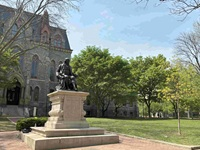Speaker
Description
We propose a new particle detection scheme that utilizes Nitrogen-Vacancy (NV) center magnetometry for probing variations in magnetic field exclusion through a superconductor as it undergoes a phase transition. We present exploratory simulation results of a Superconductor-NV center-based detector to probe the Meissner screening for low-energy event detection. A modular Python–COMSOL workflow developed in-house was used to model the detector geometry and simulate the superconducting-to-normal phase transition triggered by localized energy deposition. This phase transition alters the local magnetic field profile due to the collapse of the Meissner screening, which can be subsequently detected by the ensembles of NV centers in diamond. Simulation results show that an O(100) eV energy deposition can lead to a change in magnetic field of miliTeslas or less. Such a change in magnetic field can be detected in either the shift in the resonance frequency of the initialized NV qubit state, or the overall quenching of the fluorescence intensity. In parallel, we also describe experimental efforts towards realizing NV-based magnetometry. We present early-stage experimental efforts to achieve NV fluorescence spectroscopy by developing a cost-effective and modular optical setup along with custom-built software capabilities, capable of performing widefield and confocal fluorescence microscopy. This would eventually be used to perform NV-center-based quantum magneto-optical studies and characterize the performance of the detector.

